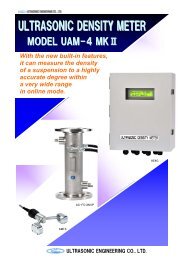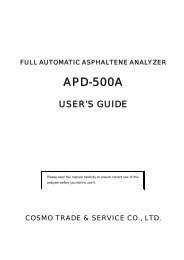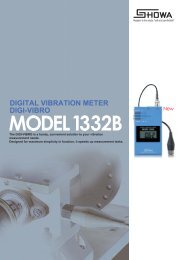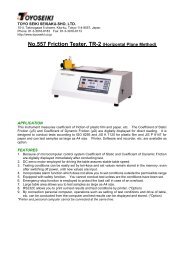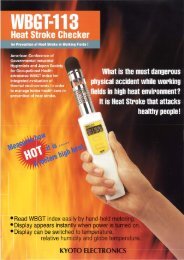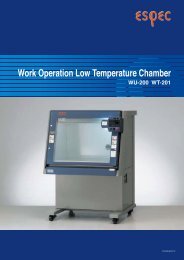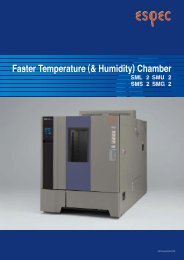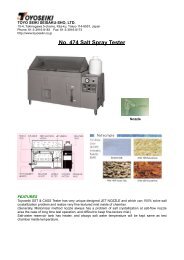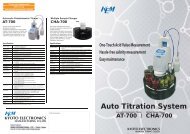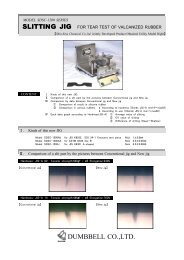JPI-5S-45-95 - Xebex.jp
JPI-5S-45-95 - Xebex.jp
JPI-5S-45-95 - Xebex.jp
You also want an ePaper? Increase the reach of your titles
YUMPU automatically turns print PDFs into web optimized ePapers that Google loves.
p.1 p.2 p.3 p.4Full-AutomaticAsphaltene AnalyzerAdvancedTechnologyPrizewas awarded bythe JapanPetroleumInstitute.Model APD-600AConforming to the “<strong>JPI</strong>-<strong>5S</strong>-<strong>45</strong>-<strong>95</strong>” test methodof Japan Petroleum InstituteRegistered PatentsJapanese patent No.1816317U.S. patentNo.4843247European patent No.02<strong>45</strong>512Canadian patent No.1286521Chinese patentNo.15940Asphaltene concentration largely affects burning characteristics of heavy oil, and itsanalysis is becoming more important now from a viewpoint of the global environment.Introduction of Asphaltene Analyzer is nowadays studied not only by petroleum industriesbut also by thermal power plants, boiler facilities, ship-building industries, ocean vessels,port and harbor authorities, etc.More than 200 sets have been already introduced to the Japanese domestic major oilrefi neries, petrochemical manufacturers as well as overseas leading petroleum companies,laboratories and universities, etc. until now.The worldwide oil resource development will further step forward to the direction of heavycrude oil, shale oil and oil sand from the conventional production and consumption of lightcrude oil, thus the Asphaltene Analysis will become further important and needed.CONTENTSBrief Overview ………… p.2Characteristics ………… p.2Method of Pretreatment/Measuring Principle … p.3Specifications ………… p.4Contact …………………… p.4
p.1 p.2 p.3 p.4Asphaltene Analyzer Model APD-600Ausing a Dual WavelengthSpectrophotometric MethodUpgraded from the conventional Model APD-500A,with the same functions and improved performanceBrief OverviewThere are two methods of ASTM D3279 and ASTMD6560 (equivalent to IP 143) in the AsphalteneTesting Methods for crude oil and petroleum oil. Bothmethods are conducted by manual gravimetric techniquein filtration process using the specified solventto calculate Asphaltene concentration. It will takehalf a day to a full one day to make this analysis, withsuch disadvantage as measured data will widely vary.Using this Asphaltene Analyzer, measurement isdone in about one minute, except the time for samplepretreatment, with much less variation of measureddata, so many sets of this analyzer have been introducedto many Japanese oil companies until now.From the said background, this dual wavelengthspectrophotometric method was formalized in 19<strong>95</strong>for Asphaltene analysis as the authorized method of‘‘<strong>JPI</strong>-<strong>5S</strong>-<strong>45</strong>-<strong>95</strong>’’ by the Japan Petroleum Institute (<strong>JPI</strong>).When using this Asphaltene Analzyer, the measurementvalues are automatically calculated as thevalues of ASTM D3279 method, which has less datavariation compared with the values of ASTM D6560(or IP 143).When this Asphaltene analysis method was formalizedby the <strong>JPI</strong>, careful study on the measurement values ofASTM D3279 and ASTM D6560 (or IP 143) was done,and it was proved as a result that there was quite goodcorrelation on the measurement values of the bothmethods.A user of this analyzer can optionally set a correlationformula even to automatically obtain the values ofASTM D6560 (or IP 143) in addition to the conventionalmeasurement values. User’s own specific correlationformula can also be set if necessary. Before the shipment from the factory, 0-100%calibration is done using the Asphaltene standardliquid (APD-006), and the working curve is madeand saved into the built-in memory. So, aftera user’s installation, the analyzer can be usedimmediately by doing the 0-100% calibration only. By setting on the turn-table your samples thathave been pretreated according to the methodspecified by the <strong>JPI</strong>, automatic measurements willbe done just by starting the operation. Samples for measurements are stirred by stirrerrotors, and sucked into the measuring cell by atubing pump. Absorbency of the sucked samples is measured,and Asphaltene concentration is calculated, thenthe results are printed out. A sequence of this operation is automaticallydone for all the samples set on the turn-table.PrinterA/DCPUTo a drain tankCharacteristics of Model APD-600AVery rapidMeasurement is made in about 1 minuteexcept a pretreatment of samples.No specific skillEveryone can make measurements by asimple pretreatment of samples.Wide variety of oilsMeasurement is applicable not only to fueloils but also to base oils, cracked residue, etc.High accuracyThis analyzer has excellent repeatabilitywithout dependence on operators.Automatic generation of working curveNo complicated calculation is required tomake a working curve.All-in-one typeMeasuring section and sample changer turntableare integrated into one unit.LED lamps as a light sourceA considerably long period of stable use isnow possible.Complete supply as standard equipmentThis analyzer is supplied as a complete setready for immediate use.Compatibility with ASTM and IP methodsThe measured results have good correlationswith those of ASTM D3279/D6560 and IP143 methods, which are internationally wellknown and applied by many users.Interference filtersPhotocellsSamplingpump3-waysolenoidvalveOperation FlowMeasuring cellRinsingpump = 750nmLEDs = 800nmFrom a rinsing liquid tankSamples
p.1 p.2 p.3 p.4Method of PretreatmentFor this Asphaltene analysis using the APD-600A,samples for measurements must be pretreatedaccording to the test method of ‘‘<strong>JPI</strong>-<strong>5S</strong>-<strong>45</strong>-<strong>95</strong>’’specified by the Japan Petroleum Institute (<strong>JPI</strong>).To do this operation of pretreatment, the followingequipment will be needed to be prepared at theplace of measurements, together with Tolueneand n-Heptane. Analytical balance(Measurable with the minimum reading of 0.0001g)Take a sampleheated to 60ºC byweighing it accrately.Add 1mL of Tolueneheated to 80ºC.Dissolve a samle toToluene sufficientlyby shaking a flask. Constant temperature chamber(With the temperature control of 60 ° C to 80ºC) Water bath(With the temperature control of 80ºC to 100ºC) Fume hood(Draft chamber, exhaust hood, etc.) Nitrogen gas for purging(Needed to keep the Asphaltene standard liquid inoxidizablefor use)Add 100mL ofn-Heptaneheated to 80ºC.Shake and stir asample solutionsufficiently.Leave a samplesolution for about40 minutes to cooldown to the roomtemperature. Laboratory glassware, etc.(500mL measuring fl ask, 100mL measuring cylinder, 1mLmeasuring pipette, disposable pipette (about 1mL), etc.)Set the pretreatedsample solutions to theanalyzer and startmeasurements.Method of PretreatmentMeasuring PrincipleA sample is dissolved by adding 1mL of Toluene,and n-Heptane heated to 80ºC is added to disperseAsphaltene particles. Absorbency of thissample solution with dispersed Asphaltene particlesis measured at 750nm and 800nm to obtainthe ratio of the 2 wavelengths. The Asphalteneconcentration is then determined from the builtinworking curve and the sample’s weight. Tocatch the absorbency of just the light scatteredby Asphaltene particles in the sample solution,very unique calculation formula has been establishedby focusing attention on the ratio of the 2wavelengths.The values as a result of measurements have verygood correlation with the measurement valuesunder the ASTM D3279 method, and it is alsopossible to output the measurement values underthe IP 143 method (or ASTM D6560 method) byinputting certain coefficient.Asphalten content by ASTM (mass %) Asphaltene content by dual wavelengh method(mass %)Correlation between dual wavelength method and ASTM methodGraph of CorrelationThermalcrackedresidueFuel oilOil sandbitumenHydrocrackedresidue
p.1 p.2 p.3 p.4Specifications of Model APD-600ASystem ConfigurationThe following three units are integrated into this analyzer.(1) Measuring and calculating unit, including control amplifier and operation panel(2) Absorbency measuring unit, including LED lamps and silicon photocells(3) Sample-changer unit (turn-table type), for max. 12 samples A printer for this analyzer is of external connection type, so two AC outletswill be needed for connection with the analyzer and printer.Specifications1 Model name APD-600A, Full-automatic Asphaltene Analyzer2 Measuringobjects3Number ofsamples formeasurement4 Measuringmethod5 Measuringrange6 Reproducibility7Output ofresults8 Display unitCrude oil, heavy oil, cracked residue (normalpressure or reduced pressure), asphalt, varioustypes of cracked oils, shale oil and oil sand:However, measurement by the APD-600A is notavailable for the samples containing Tolueneinsoluble components such as sludge, the samplescontaining a large amount of wax with a pour pointof 50ºC or higher, and blown asphalt.Max. 12 samples (*Measuring conditions aresettable for max. 24 samples.)Conforming to the <strong>JPI</strong>-<strong>5S</strong>-<strong>45</strong>-<strong>95</strong> test methodAbsorption spectroscopy (Wavelength =750 &800 nm)a) Light source: LED lampsb) Photo sensor: Silicon photocells0.5 to 15 wt%[Absorbency accuracy of soluble matter] ±2% (in thevicinity of Abs. 2.5, when converted to 10mm cell)Display (fl uorescent character display: 16 digits x 2lines) and Printer (IDP-100, for external connection)Abs *.*** (3 digits after the decimal point) and****mV (4 digits)9 Sampling Automatic sampling by tubing pump10 Cleaningmethod11 Sequence12 Measuringtime13 FunctionRinse by tubing pumpSeq-1: Measurement onlySeq-2: Measurement and rinseSeq-3: Sequence to make a working curveApprox. 1 minute per sample (for absorbencymeasurement only)Re-calculationAutomatic statistical calculationCalendar14 External output Printer port x 1 and Serial port x 115 Environmentfor useTemperature 5 to 35ºC and Humidity 85%RH orless (no condensation)16 Power supply 100 to 240V AC +/-10%, 50/60Hz17 Weight Approx. 20kg18 Dimensions520(W) × 428(D) × 350(H) mm (excluding drain andrinsing liquid tanks)Results of measurementsTo be output to an external printer or output via RS-232C interfaceStandard accessoriesThe following accessories and consumables are supplied together withthe APD-600A.Printer (for plain paper)Printer paperInk cartridgePower cableTank (for drain and rinsing liquid)Erlenmeyer fl ask (with plug)Flask holderStirrer rotor1 set4 rolls5 pieces1 piece2 pieces12 pieces12 pieces12 piecesStandard Asphaltene liquid (for calibration) 1 bottleOperation manual1 copyOptionThe following software is available in option for output of measurementresults to PC.Soft-CapE / RS-232C cableRemarksMeasuring method is based on the “<strong>JPI</strong>-<strong>5S</strong>-<strong>45</strong>-<strong>95</strong>” test method of theJapan Petroleum Institute.Prepare Toluene (grade of reagent, 99.5% or higher purity) andn-Heptane (grade of reagent, 99% or higher purity) for this Asphalteneanalysis.To obtain good results of measurements, it is very important to payattention to the weights of samples you will take and the control oftemperature and time for sample pretreatment.Conforming to CEFor more information, please contact:Sales agent<strong>Xebex</strong> International, Ltd.105, Shakujii-machi 2-1-4, Nerima-ku, Tokyo 177-0041, JapanTel. 81-3-5372-2581, Fax. 81-3-5372-2583 Email: info@xebex.<strong>jp</strong>ManufacturerTENNOZ-PARKSIDE BLDG.,5-8, Higashi-Shinagawa 2-Chome, Shinagawa-ku, Tokyo 140-8614, JapanManufacturing is subcontracted to: KYOTO ELECTRONICS MANUFACTURING CO., LTD.



